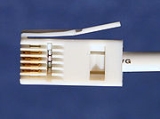
British telephone sockets
Encyclopedia
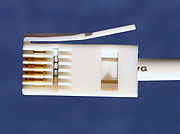
BT Group
BT Group plc is a global telecommunications services company headquartered in London, United Kingdom. It is one of the largest telecommunications services companies in the world and has operations in more than 170 countries. Through its BT Global Services division it is a major supplier of...
to allow subscribers to connect their own telephones. They are governed by British Standard BS6312.
They are similar to modular connector
Modular connector
Modular connector is the name given to a family of electrical connectors originally used in telephone wiring and now used for many other purposes. Many applications that originally used a bulkier, more expensive connector have now migrated to modular connectors...
s (as used in RJ11
Registered jack
A registered jack is a standardized physical network interface — both jack construction and wiring pattern — for connecting telecommunications or data equipment to a service provided by a local exchange carrier or long distance carrier. The standard designs for these connectors and their wiring...
), but feature a side-mounted hook, rather than a bottom-mounted one, and are physically incompatible.
History
Standard sockets were introduced, as part of the 'New Plan' wiring policy, to allow customers to easily purchase their own telephones, as required by OftelOftel
Oftel has been superseded as the British telecommunications regulator by Ofcom .----The Office of Telecommunications was a department in the United Kingdom government, under civil service control, charged with promoting competition and maintaining the interests of consumers in the UK...
, the phone regulator. Thus any phone whose plug conformed to BS6312 and met certain other regulatory standards, such as BABT, could be connected to the network, rather than British Telecom controlling the market. The 'New Plan' was only new to the UK and was based extensively on systems which had been available elsewhere for many years, especially in the US.
The new system replaced the older hard-wired system, which came in many 'flavours', e.g. Plans 1, 1A, 1B, 1C, 2, 2A, 105, 107 etc, which could be very complicated and required the attendance at the premises of a GPO telephone-engineer, who needed a complete set of 'N' (wiring) Diagrams, which was very extensive and ran to over 15 volumes of little, black, ring binders. N diagrams also had their own numbering system e.g. a Plan 1A had an N diagram of N4502, and were frequently updated.
From the early years of the 1900's, the GPO (subsequently British Telecom) did have a plug and socket system available for rent (See Plate 3 in the 1909 edition of the Post Office Telegraphs 'Connections of Telephonic Apparatus and Circuits' 1909 edition) It was later called a "Plan 4" (N762 - first edition not later N762!), and employed a heavy-duty, four-way jack plug 404, (circular in cross-section), on the end of the standard, plaited, cotton covered instrument cord. It also had to have a separate Bell-Set which was permanently in-circuit to provide ringing if there were no telephones plugged in. This system survived through various models of telephones from the 'candlestick', 200 ad 300 type bakelite phones until the introduction of the 700 series in 1959 when a smaller 'Plug 420' was introduced. The separate bell-set, with its on-board capacitor and coils, also provided a testing circuit for remote engineers, by providing the mandatory 1000ohm, capacitive loop-back. Rental had to be paid on each telephone and on all the sockets, and hence was not that common.
Master socket and NTE-5 Line Box
A domestic single British telephone line installation will have a single master socket or line box in the premises, which is provided by BT or another service provider: this socket is the demarcation pointDemarcation point
In telephony, the demarcation point is the point at which the public switched telephone network ends and connects with the customer's on-premises wiring. It is the dividing line which determines who is responsible for installation and maintenance of wiring and equipment -- customer/subscriber, or...
between the customer-owned and maintained on-premises wiring
On-premises wiring
In telecommunication, on-premises wiring is customer-owned communications transmission lines. It is also called customer premises wiring . The transmission lines can be metallic or optical fiber, and may be installed within or between buildings.Premises wiring may consist of horizontal wiring,...
, and the telephone network. For installations using the NTE-5 line box, the demarcation point is actually within the socket: the lower half of the front plate and associated wiring is the customer's, while the permanent wiring on the non-removable section behind this, remains the responsibility of the service provider. Customers are not permitted to access the wiring in a master socket without a removable lower section. Plug-in extension kits are available for customers with this type of installation.
This master socket contains a high voltage surge protection (SP1) to suppress high voltage spikes etc, a 1.8 µF capacitor (Bell Circuit) to feed the AC ringing and a 470 kΩ resistor (R1 Out of Service Resistor) to provide remote testing when no telephones are plugged into any sockets. Additional internal extension (secondary) sockets are wired off the master socket (connected in parallel using the IDC
Insulation-displacement connector
An Insulation-displacement connector, insulation-displacement technology/termination or insulation-piercing connector is an electrical connector designed to be connected to the conductor of an insulated wire or cable by a connection process which forces a selectively sharpened blade or blades...
system) and do not contain the surge protector, bell circuit capacitor and the out-of-service resistor.
Old style: Fixed plate
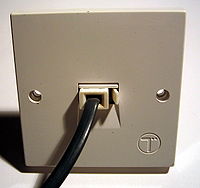
New style: Removable plate (NTE5)
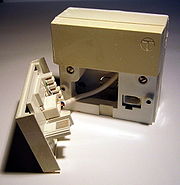
Insulation-displacement connector
An Insulation-displacement connector, insulation-displacement technology/termination or insulation-piercing connector is an electrical connector designed to be connected to the conductor of an insulated wire or cable by a connection process which forces a selectively sharpened blade or blades...
s (IDCs) instead of screw terminals on the back piece, known as a CTE5.
Now that BT does not have a monopoly of internal wiring, they make a substantial charge if a fault reported to them turns out to be in the customer's internal/domestic wiring. It is therefore important for the customer to have the facility to check whether any problem or fault is in their internal wiring/equipment or externally in BT's cabling or systems. Since the NTE5 socket represents the official demarcation point
Demarcation point
In telephony, the demarcation point is the point at which the public switched telephone network ends and connects with the customer's on-premises wiring. It is the dividing line which determines who is responsible for installation and maintenance of wiring and equipment -- customer/subscriber, or...
between the internal/domestic wiring (at the removable front of the socket which is the customer's responsibility) and the external telephone line/cabling fixed at the rear (which is BT's responsibility) the physical disconnection of the two wirings (made possible by the NTE5's removable front plate) is crucial in identifying faults and allocating responsibility for their rectification.
Plugs


431A is 4-way and 631A 6-way. They fit a standard "Type 600" telephone socket. There are also plugs with only two contacts commonly seen on modem leads. These are a recent introduction and do not seem to be easily available as separate parts.
The Sinclair QL
Sinclair QL
The Sinclair QL , was a personal computer launched by Sinclair Research in 1984, as the successor to the Sinclair ZX Spectrum...
and 128k ZX Spectrum
ZX Spectrum
The ZX Spectrum is an 8-bit personal home computer released in the United Kingdom in 1982 by Sinclair Research Ltd...
home computer
Home computer
Home computers were a class of microcomputers entering the market in 1977, and becoming increasingly common during the 1980s. They were marketed to consumers as affordable and accessible computers that, for the first time, were intended for the use of a single nontechnical user...
s used type 630W connectors for their serial ports (on the Spectrum 128 and +2, MIDI signals could also be sent from the port). These closely resemble standard 631A connectors but the keying slots on the back of the plug have a different size and position.
The 430A and 630A plugs had the latch on the opposite side of the plug, and were used as headset plugs on some switchboards and as handset connectors on some telephones, eg Ambassador.
The 631A and 630A plugs are also used for connecting sensors to interfaces for computer based measurements in educational environments, the former for connecting analogue sensors and the latter for digital sensors. Companies using these plugs include Vernier, TI and Casio, for interfaces connecting to their graphical calculators, and in the Netherlands CMA. They all use the same pinning.
Connector on phone
The connector on the phone is not standardized: the connector at the wall is standardized by regulation, to allow individuals to use their own phones (interconnectionInterconnection
In telecommunications, interconnection is the physical linking of a carrier's network with equipment or facilities not belonging to that network...
), but the wire from the phone to the wall may be hard-wired to the phone, or use various connectors.
Typically it will have a 6P4C or 6P2C modular connector
Modular connector
Modular connector is the name given to a family of electrical connectors originally used in telephone wiring and now used for many other purposes. Many applications that originally used a bulkier, more expensive connector have now migrated to modular connectors...
at the telephone end: this latter may be wired as per the RJ11 standard (with pins 3 and 4), or it may be wired with pins 2 and 5, as a straight through cable from the BT plug (which uses pins 2 and 5 for the line, unlike RJ11, which uses pins 3 and 4). Thus cables are not in general compatible between different phones, as the phone base may have a socket with pins 2 and 5 (requiring a straight through cable), or have an RJ11 socket (requiring a crossover cable
Crossover cable
A crossover cable connects two devices of the same type, for example DTE-DTE or DCE-DCE, usually connected asymmetrically , by a modified cable called a crosslink...
).
Use in other countries
The BS 6312 jack has been used in New Zealand since the 1980s, replacing a number of other connectors and hard-wired connections, and was subsequently replaced by a "2-wire" version suited to daisy chain wiring that eliminated the 3rd ringing voltage wire. The "BT Jack" is still the most common phone jack in use, although many installations in business use structured cablingStructured cabling
Structured cabling is building or campus telecommunications cabling infrastructure that consists of a number of standardized smaller elements called subsystems.Structured cabling falls into six subsystems:...
with "RJ45" 8p8c modular connectors for telephone as well as data services. Since 2010 the TCF Premises Wiring Code of Practice has deprecated BT jacks in favour of "RJ45" modular jacks for all new residential and SOHO phone/data networks, although not yet a mandatory standard in 2011.
It is also used in Bahrain
Bahrain
' , officially the Kingdom of Bahrain , is a small island state near the western shores of the Persian Gulf. It is ruled by the Al Khalifa royal family. The population in 2010 stood at 1,214,705, including 235,108 non-nationals. Formerly an emirate, Bahrain was declared a kingdom in 2002.Bahrain is...
, Bangladesh
Bangladesh
Bangladesh , officially the People's Republic of Bangladesh is a sovereign state located in South Asia. It is bordered by India on all sides except for a small border with Burma to the far southeast and by the Bay of Bengal to the south...
, Belize
Belize
Belize is a constitutional monarchy and the northernmost country in Central America. Belize has a diverse society, comprising many cultures and languages. Even though Kriol and Spanish are spoken among the population, Belize is the only country in Central America where English is the official...
, Botswana
Botswana
Botswana, officially the Republic of Botswana , is a landlocked country located in Southern Africa. The citizens are referred to as "Batswana" . Formerly the British protectorate of Bechuanaland, Botswana adopted its new name after becoming independent within the Commonwealth on 30 September 1966...
, Brunei
Brunei
Brunei , officially the State of Brunei Darussalam or the Nation of Brunei, the Abode of Peace , is a sovereign state located on the north coast of the island of Borneo, in Southeast Asia...
, Cyprus
Cyprus
Cyprus , officially the Republic of Cyprus , is a Eurasian island country, member of the European Union, in the Eastern Mediterranean, east of Greece, south of Turkey, west of Syria and north of Egypt. It is the third largest island in the Mediterranean Sea.The earliest known human activity on the...
, Eritrea
Eritrea
Eritrea , officially the State of Eritrea, is a country in the Horn of Africa. Eritrea derives it's name from the Greek word Erethria, meaning 'red land'. The capital is Asmara. It is bordered by Sudan in the west, Ethiopia in the south, and Djibouti in the southeast...
, the Falkland Islands
Falkland Islands
The Falkland Islands are an archipelago in the South Atlantic Ocean, located about from the coast of mainland South America. The archipelago consists of East Falkland, West Falkland and 776 lesser islands. The capital, Stanley, is on East Falkland...
, Ghana
Ghana
Ghana , officially the Republic of Ghana, is a country located in West Africa. It is bordered by Côte d'Ivoire to the west, Burkina Faso to the north, Togo to the east, and the Gulf of Guinea to the south...
, Gibraltar
Gibraltar
Gibraltar is a British overseas territory located on the southern end of the Iberian Peninsula at the entrance of the Mediterranean. A peninsula with an area of , it has a northern border with Andalusia, Spain. The Rock of Gibraltar is the major landmark of the region...
, Israel
Israel
The State of Israel is a parliamentary republic located in the Middle East, along the eastern shore of the Mediterranean Sea...
, Jordan
Jordan
Jordan , officially the Hashemite Kingdom of Jordan , Al-Mamlaka al-Urduniyya al-Hashemiyya) is a kingdom on the East Bank of the River Jordan. The country borders Saudi Arabia to the east and south-east, Iraq to the north-east, Syria to the north and the West Bank and Israel to the west, sharing...
, Kenya
Kenya
Kenya , officially known as the Republic of Kenya, is a country in East Africa that lies on the equator, with the Indian Ocean to its south-east...
, Kuwait
Kuwait
The State of Kuwait is a sovereign Arab state situated in the north-east of the Arabian Peninsula in Western Asia. It is bordered by Saudi Arabia to the south at Khafji, and Iraq to the north at Basra. It lies on the north-western shore of the Persian Gulf. The name Kuwait is derived from the...
, Lesotho
Lesotho
Lesotho , officially the Kingdom of Lesotho, is a landlocked country and enclave, surrounded by the Republic of South Africa. It is just over in size with a population of approximately 2,067,000. Its capital and largest city is Maseru. Lesotho is a member of the Commonwealth of Nations. The name...
, Malawi
Malawi
The Republic of Malawi is a landlocked country in southeast Africa that was formerly known as Nyasaland. It is bordered by Zambia to the northwest, Tanzania to the northeast, and Mozambique on the east, south and west. The country is separated from Tanzania and Mozambique by Lake Malawi. Its size...
, Malta
Malta
Malta , officially known as the Republic of Malta , is a Southern European country consisting of an archipelago situated in the centre of the Mediterranean, south of Sicily, east of Tunisia and north of Libya, with Gibraltar to the west and Alexandria to the east.Malta covers just over in...
, Myanmar (Burma)
Myanmar
Burma , officially the Republic of the Union of Myanmar , is a country in Southeast Asia. Burma is bordered by China on the northeast, Laos on the east, Thailand on the southeast, Bangladesh on the west, India on the northwest, the Bay of Bengal to the southwest, and the Andaman Sea on the south....
, Nigeria
Nigeria
Nigeria , officially the Federal Republic of Nigeria, is a federal constitutional republic comprising 36 states and its Federal Capital Territory, Abuja. The country is located in West Africa and shares land borders with the Republic of Benin in the west, Chad and Cameroon in the east, and Niger in...
, Oman
Oman
Oman , officially called the Sultanate of Oman , is an Arab state in southwest Asia on the southeast coast of the Arabian Peninsula. It is bordered by the United Arab Emirates to the northwest, Saudi Arabia to the west, and Yemen to the southwest. The coast is formed by the Arabian Sea on the...
, Qatar
Qatar
Qatar , also known as the State of Qatar or locally Dawlat Qaṭar, is a sovereign Arab state, located in the Middle East, occupying the small Qatar Peninsula on the northeasterly coast of the much larger Arabian Peninsula. Its sole land border is with Saudi Arabia to the south, with the rest of its...
, Saudi Arabia
Saudi Arabia
The Kingdom of Saudi Arabia , commonly known in British English as Saudi Arabia and in Arabic as as-Sa‘ūdiyyah , is the largest state in Western Asia by land area, constituting the bulk of the Arabian Peninsula, and the second-largest in the Arab World...
, Swaziland
Swaziland
Swaziland, officially the Kingdom of Swaziland , and sometimes called Ngwane or Swatini, is a landlocked country in Southern Africa, bordered to the north, south and west by South Africa, and to the east by Mozambique...
, Tanzania
Tanzania
The United Republic of Tanzania is a country in East Africa bordered by Kenya and Uganda to the north, Rwanda, Burundi, and the Democratic Republic of the Congo to the west, and Zambia, Malawi, and Mozambique to the south. The country's eastern borders lie on the Indian Ocean.Tanzania is a state...
, the United Arab Emirates
United Arab Emirates
The United Arab Emirates, abbreviated as the UAE, or shortened to "the Emirates", is a state situated in the southeast of the Arabian Peninsula in Western Asia on the Persian Gulf, bordering Oman, and Saudi Arabia, and sharing sea borders with Iraq, Kuwait, Bahrain, Qatar, and Iran.The UAE is a...
, Zambia
Zambia
Zambia , officially the Republic of Zambia, is a landlocked country in Southern Africa. The neighbouring countries are the Democratic Republic of the Congo to the north, Tanzania to the north-east, Malawi to the east, Mozambique, Zimbabwe, Botswana and Namibia to the south, and Angola to the west....
, and Zimbabwe
Zimbabwe
Zimbabwe is a landlocked country located in the southern part of the African continent, between the Zambezi and Limpopo rivers. It is bordered by South Africa to the south, Botswana to the southwest, Zambia and a tip of Namibia to the northwest and Mozambique to the east. Zimbabwe has three...
. The jack is still found in Hong Kong
Hong Kong
Hong Kong is one of two Special Administrative Regions of the People's Republic of China , the other being Macau. A city-state situated on China's south coast and enclosed by the Pearl River Delta and South China Sea, it is renowned for its expansive skyline and deep natural harbour...
, where new installations ceased in 1998, while in Saint Vincent and the Grenadines
Saint Vincent and the Grenadines
Saint Vincent and the Grenadines is an island country in the Lesser Antilles chain, namely in the southern portion of the Windward Islands, which lie at the southern end of the eastern border of the Caribbean Sea where the latter meets the Atlantic Ocean....
, new installations ceased in 2001, with RJ11
Registered jack
A registered jack is a standardized physical network interface — both jack construction and wiring pattern — for connecting telecommunications or data equipment to a service provided by a local exchange carrier or long distance carrier. The standard designs for these connectors and their wiring...
now used instead.
Making the connections
As previously mentioned the actual connections are made using Insulation-displacement connectorInsulation-displacement connector
An Insulation-displacement connector, insulation-displacement technology/termination or insulation-piercing connector is an electrical connector designed to be connected to the conductor of an insulated wire or cable by a connection process which forces a selectively sharpened blade or blades...
s (IDC). A punch down tool
Punch down tool
A punch down tool, also called a punchdown tool or a krone tool , is a small hand tool used by telecommunication and network technicians...
is required to do this and two sorts are available. One is of plastic construction and only intended for occasional use. The other is a tool manufactured by Krone and is of more robust construction : an example is shown in the photograph. It also comes with a tool for removing wires from sockets. The outer sheath of the cable is removed but the insulation from each wire is left and just placed in the connector. The Krone tool both inserts the wire into the connector and cuts off the excess wire in one action. The action of pushing the wire into the connector cuts into the insulation and makes contact with the wire. A maximum of three wires can be attached to each connector but it is best to stick to two if possible as the third is not usually a good connection.
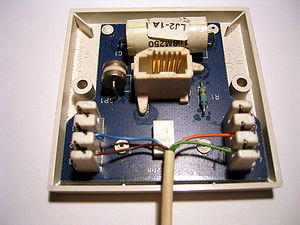
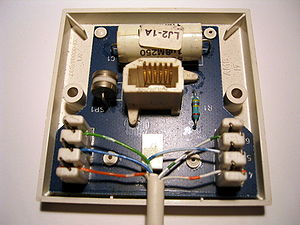
Cabling arrangements
Shown below are the cabling arrangements for both 4-wire and 6-wire cable. Initially 4 wire was used and many older installations still use it, until recent months however the 6-wire was the new standard, but the 4-wire, has now been reissued to all Openreach engineers as part of cost savings. The modern 4 wire is however the same diameter as 6 wire to allow engineers to use existing tacking guns and cable clips. Note that the wires in the 6-wire cable are coloured with two colours in a ratio of four to one in length, with the first colour mentioned being the predominant colour, e.g. if the colour of the wire is W-B then the wire will be coloured White for 12mm, then Blue for 3mm and so on. In other words it looks like a white wire with blue patches on it.Strictly speaking, a textbook installation will only actually use pins 2, 5 (for the voice) and 3 (for the ringer). Having said this, most modern telephones contain their own ringing capacitor, to cater for badly wired extensions, which means you can usually run your extension wiring with only pins 2 and 5. Often where multi-core cable is used, the remaining cables are used for wiring extensions on additional incoming telephone lines.
Broadband
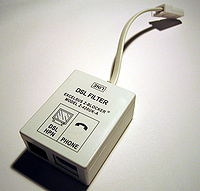

Broadband Internet access
Broadband Internet access, often shortened to just "broadband", is a high data rate, low-latency connection to the Internet— typically contrasted with dial-up access using a 56 kbit/s modem or satellite Internet with inherently high latency....
internet
Internet
The Internet is a global system of interconnected computer networks that use the standard Internet protocol suite to serve billions of users worldwide...
services simultaneously with voice telephony, it is necessary to use a DSL filter
DSL filter
A DSL filter is an analog low-pass filter installed between analog devices and a plain old telephone service telephone line, in order to prevent interference between such devices and a digital subscriber line service operating on the same line...
. This is basically two filters, which divide the single line into two discrete channels. Enough bandwidth is retained for voice telephony and the majority is used for high speed data. All phones must be connected via a filter (either a separate filter for each phone or one filter covering multiple phones) to avoid interference between the phones and the DSL signal. Where the data transmission is still unduly audible, using two DSL filters, daisychained in tandem, will eliminate the problem. The DSL modem connects directly to the phone line (most DSL filters have a socket marked DSL that just connects directly through to the incoming phone line). The ringer wire is unnecessary in unfiltered parts of the wiring and its removal can often improve performance and reliability of the broadband service.
When ADSL was first introduced in the UK it was installed by an engineer who replaced the front part of the NTE5 (if the property still had an old style master socket it would be replaced with an NTE5) with one containing a filter. Any hardwired phone extensions were disconnected from the original front part and connected to filtered terminals on the back of the filter. The DSL modem (which at the time was also BT supplied) and, if present, a phone or plug-in extension, could then be plugged into the front. If it was desired to locate the DSL modem away from the master socket a plug-in ADSL extension kit could be purchased.
BT also offered "wires only" ADSL service and promoted the technique of using a separate plug-in filter on every socket. While both technically inferior and far less tidy than the solution BT engineers had used, it was usually adequate and was simple enough for a non technical householder to understand. The more discerning customer can purchase a variety of hardwired filtering products, including replacement front plates for the NTE5, some of which have unfiltered as well as filtered terminals on the back to avoid the need to plug in the extension wiring that leads to the DSL modem.


